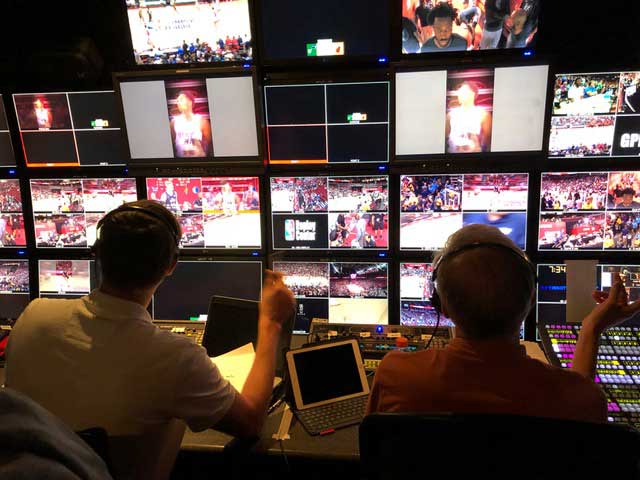New Ads Get a Summer League Tryout

Why This Matters: Sports leagues and networks are working to maintain the value of advertising during games as TV ratings shrink.
Rookies aren’t the only ones trying out new moves in the NBA Summer League.
The NBA is using broadcasts of the games to try out ways to keep viewers tuned in longer and create more value for sponsors.
The league is also testing new production elements, employing different camera technologies as its teams look at rule changes.
Like other leagues, the NBA is tinkering with its presentation on TV at a time when viewers have more choices and are consuming sports in different ways.
Last week, during Major League Baseball’s Home Run Derby, instead of cutting to a commercial break, ESPN stayed with the action using a two-box format with on-field activity in one box and commercial messages in the other. Last season, the NFL adjusted its broadcasts to create fewer interruptions.
“I think everyone in the media business is really on this quest to retain viewership and increase average time spent viewing,” Paul Benedict, director, broadcasting content management for the NBA, said. As part of its Optimal Broadcast Initiative, “we’re looking at the future of media and the melding of social, digital, mobile and linear all together. No one knows where this is ultimately going, but we want to stay ahead of it.”
Broadcasting & Cable Newsletter
The smarter way to stay on top of broadcasting and cable industry. Sign up below
Weaving In the Breaks
One of the techniques designed to keep people tuned in during commercials is what the NBA calls a continuous break — game action stops, but instead of cutting to a bunch of spots, sponsor messages are woven into the broadcast as basketball content continues.
Last season, Turner did a 45-second continuous break in which the announcers delivered a message for Straight Talk Wireless, Benedict said.
The trick is making sure the commercial message gets delivered in an engaging way, Benedict said. Clients felt that one execution — having an ad in one box and a scroll of Twitter comments in the other — was distracting, drawing viewers’ eyes away from the ad.
“We have a laundry list of ideas of different continuous break executions, different six-second ad executions, just really rethinking the entire screen, the entire format of the game in terms of how can we cleverly integrate more sponsorship type elements,” Benedict said.
Six-second spots could be almost as prevalent as three-point shots next season.
“Some of the other leagues and networks have successfully implemented them,” said Benedict. “I think our game is a little more built for it. Between free throws and dead balls, we have the ability to implement six-second ads pretty easily.
Vertical Heights

During Summer League, the NBA is also pumping out game action designed to be viewed vertically on a mobile phone. The idea grew from a request from the NBA’s office in China, where Tencent is a key media partner. Market research suggested between 75% and 80% of fans were consuming mobile content vertically; they weren’t flipping their phone horizontally.
The vertical video is shot in the traditional 15-by-9 format, but camera personnel and directors are given a vertical outline on their viewfinder to reframe action and the video is cropped in by apps on the phone.
The vertical view lets viewers use other phone functions the league could take advantage of.
“A thumb swipe maybe takes you to scores around the league, maybe it takes you to your favorite player’s profile, maybe it takes you to your Twitter page,” Steve Hellmuth, NBA executive VP, media operations and technology, said.
Another view that appears to be popular with younger fans is one that provides a viewpoint similar to the NBA 2K video game using a SkyCam.
The NBA is looking to keep viewers involved through interactivity and gamification, Benedict said. Those interactive elements can be sponsored.
One Summer League game broadcast featured “dueling announcers,” in which two color men tried to generate reactions on social media and win points from the play-by-play guy, who acted as the moderator. “It was almost a game show format,” Benedict said. It was a slow, low-scoring game, and the “competitive aspect actually brought some extra energy out of our talent.”
The NBA also is using portal technology through its NBA augmented reality app. “You can essentially walk out onto the court at the summer league and using your phone look around at 360 degrees,” Hellmuth said. “You can use this while you’re watching the game to check out to see your brother in the stands or to actually just get a feel for what the crowd’s like.”
Jon has been business editor of Broadcasting+Cable since 2010. He focuses on revenue-generating activities, including advertising and distribution, as well as executive intrigue and merger and acquisition activity. Just about any story is fair game, if a dollar sign can make its way into the article. Before B+C, Jon covered the industry for TVWeek, Cable World, Electronic Media, Advertising Age and The New York Post. A native New Yorker, Jon is hiding in plain sight in the suburbs of Chicago.










